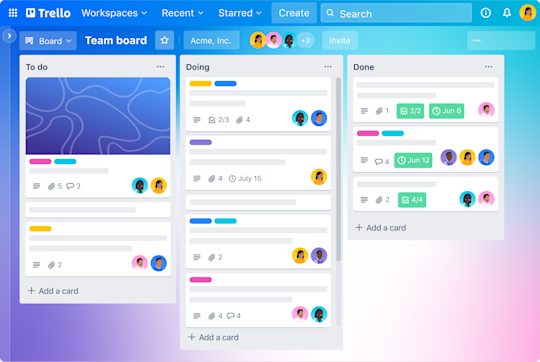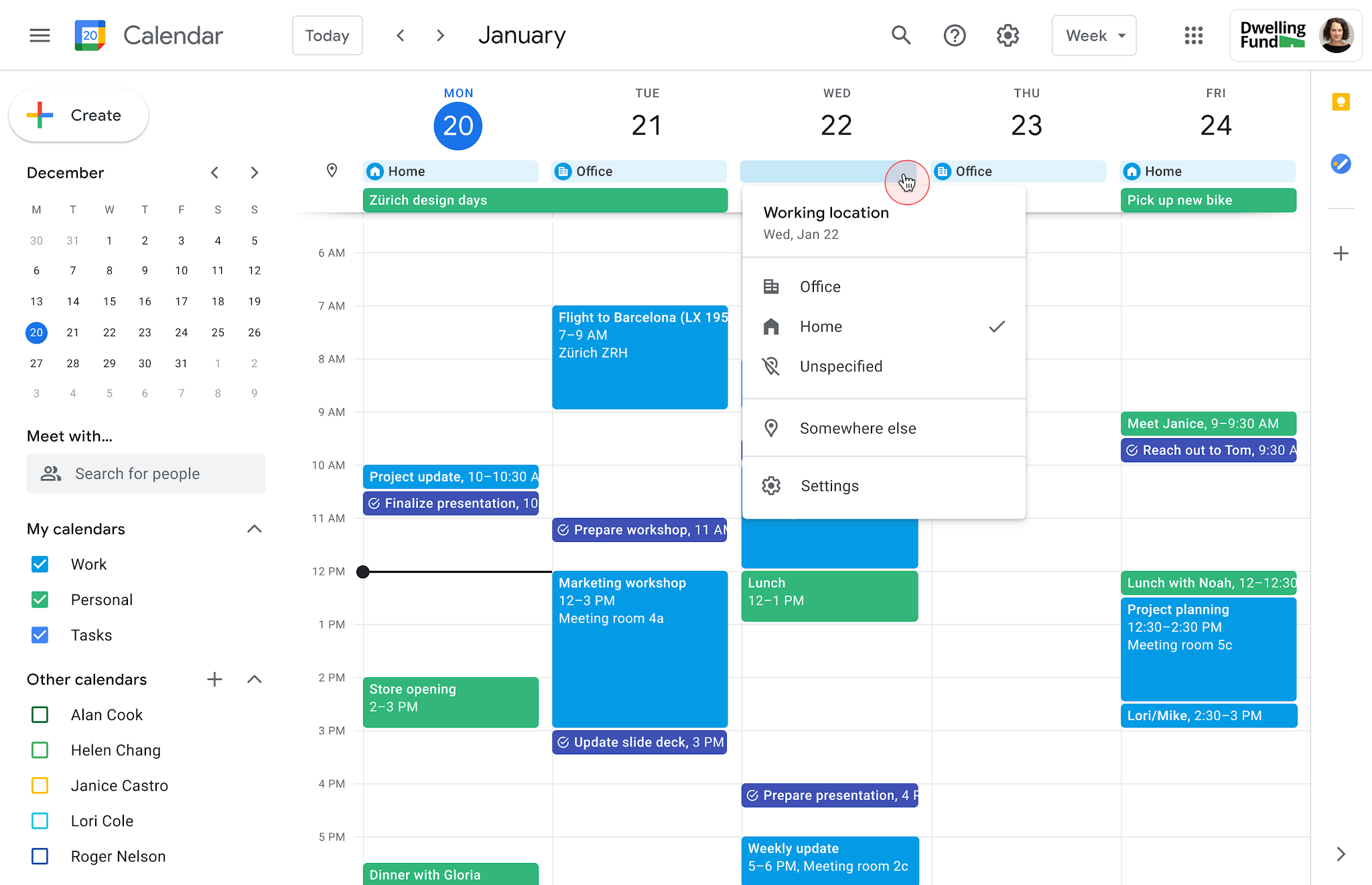Back to all comparisons
Trello vs Google Calendar
Comprehensive comparison to help you choose the right tool for your needs

Trello
4.4
Trello is a visual collaboration tool for planning tasks and projects. With an intuitive interface of boards, lists, and cards, it helps teams organize work and manage projects effectively.
Free Plan for individuals and small teams, Standard Plan at $5 per user/month (billed annually), Premium Plan at $10 per user/month (billed annually), and an Enterprise Plan for larger organizations at $17.50 per user/month (billed annually)
Visit Website Google Calendar
4.5
Google Calendar is a free tool for scheduling, with features like event creation, Google service integration, and mobile access
Free to use
Visit Website Quick Summary
Trello Strengths
- Board Organization: Trello's boards enable visual management of projects using lists and cards, enhancing visibility and tracking.
- Customizable Cards: Cards can be enhanced with descriptions, checklists, labels, and attachments, providing essential task details in one place.
- Team Collaboration: The platform supports real-time team collaboration, ensuring everyone is updated and in sync.
- Drag-and-Drop Interface: Its intuitive interface allows easy movement of cards between lists for updating priorities and workflow.
Google Calendar Strengths
- Seamless Integration with Google Services: Google Calendar is tightly integrated with Google's ecosystem, including Gmail for event invitations, Google Meet for video conferencing directly from calendar invites, and Google Tasks for task management. This integration enhances productivity by keeping all tools in one accessible location.
- Easy Event Scheduling and Sharing: The platform enables users to quickly add events, set reminders, and share their calendars with others. This feature is designed to facilitate collaboration and ensure that scheduling meetings or events is a hassle-free process, making it ideal for both personal and professional use.
- Customizable Views and Event Colors: Users can customize their calendar views (day, week, month, or year) and assign colors to different events, making it easier to manage and visually distinguish between various types of appointments or tasks at a glance.
- Recurring Events and Reminders: Google Calendar supports the creation of recurring events and configurable reminders, which can be set to notify users via email or pop-up messages. This ensures that important dates are not missed and helps in establishing routines.
Trello Screenshot

Google Calendar Screenshot

Feature Comparison
| Feature | Trello | Google Calendar |
|---|---|---|
| Platforms | macOS, iOS, Android, Web, and Windows | macOS, iOS, Android, Web |
| Integrations | Trello integrates with several apps including Google Drive, Google Chat, Google Hangouts, Google Slides, Jira, Slack, GitHub, Dropbox, and Zendesk | ClickUp, Google Tasks, Zoom, Slack, Salesforce, Google Docs |
| Calendar | Yes. Trello offers a Calendar view which is available for Premium and Enterprise plans. | Yes |
| Task Management | Trello provides features like advanced checklists, labels for prioritization, and the ability to manage recurring tasks | NA for Calendar |
| Natural Language Processing | No | Yes |
| Analytics | Trello offers basic task analytics, particularly when integrated with tools like Zapier and Google Sheets for data analysis. | No |
| Time Blocking | While Trello itself does not have a native time blocking feature, it can be used in conjunction with time blocking techniques | Yes |
| Time Zones | Yes | Yes |
| Scheduler | No | Yes |
| Notifications | Yes | Yes |
| Pricing | Free Plan for individuals and small teams, Standard Plan at $5 per user/month (billed annually), Premium Plan at $10 per user/month (billed annually), and an Enterprise Plan for larger organizations at $17.50 per user/month (billed annually) | Free to use |
| Customer Support | Good | Average |
Video Overview
Trello Video
Google Calendar Video
Trello Overview
It's known for its easy-to-use Kanban board approach but also offers other views like timelines and calendars. Trello is great for visual organization and team collaboration, with features like customizable cards, labels, and notifications. However, it may be less feature-rich compared to some alternatives like ClickUp or Monday.com, particularly in areas like advanced reporting or analytics. Trello's simplicity makes it accessible but might not suffice for complex project management needs.
Pricing Details
Trello offers several pricing plans: (i) Free Plan: $0, suitable for individuals or small teams to organize projects. (ii) Standard Plan: $5 per user/month (billed annually) or $6 monthly, for small teams needing work management and collaboration scaling. (iii) Premium Plan: $10 per user/month (billed annually) or $12.50 monthly, for teams tracking multiple projects with various visualization tools. (iv) Enterprise Plan: $17.50 per user/month (billed annually), providing connectivity, security, and controls for organizations.
Google Calendar Overview
Google Calendar is free-to-use calendar application that excels in event planning, appointment scheduling, and integrating seamlessly with Google's suite of services including Docs, Meet, and Tasks. It boasts features such as easy event scheduling, comprehensive integration with other Google services, sharing and collaboration tools, mobile access, automatic syncing across devices, customization options, and support for recurring events. Additionally, it offers functionalities like invitations and RSVP tracking, reminders, time management tools, search capabilities, holiday calendars, and weather integration for upcoming events.
Pricing Details
Free to use
Trello Key Features
Board Organization: Trello's boards enable visual management of projects using lists and cards, enhancing visibility and tracking.
Customizable Cards: Cards can be enhanced with descriptions, checklists, labels, and attachments, providing essential task details in one place.
Team Collaboration: The platform supports real-time team collaboration, ensuring everyone is updated and in sync.
Drag-and-Drop Interface: Its intuitive interface allows easy movement of cards between lists for updating priorities and workflow.
Labels and Filters: These help in categorizing and organizing tasks, with customizable label colors and names.
Notifications and Reminders: They keep users informed about due dates and important updates, ensuring task deadlines are met.
Google Calendar Key Features
Seamless Integration with Google Services: Google Calendar is tightly integrated with Google's ecosystem, including Gmail for event invitations, Google Meet for video conferencing directly from calendar invites, and Google Tasks for task management. This integration enhances productivity by keeping all tools in one accessible location.
Easy Event Scheduling and Sharing: The platform enables users to quickly add events, set reminders, and share their calendars with others. This feature is designed to facilitate collaboration and ensure that scheduling meetings or events is a hassle-free process, making it ideal for both personal and professional use.
Customizable Views and Event Colors: Users can customize their calendar views (day, week, month, or year) and assign colors to different events, making it easier to manage and visually distinguish between various types of appointments or tasks at a glance.
Recurring Events and Reminders: Google Calendar supports the creation of recurring events and configurable reminders, which can be set to notify users via email or pop-up messages. This ensures that important dates are not missed and helps in establishing routines.
Mobile Accessibility and Offline Support: With its mobile app, Google Calendar offers the convenience of accessing and managing your schedule on the go. Additionally, offline support means you can view your calendar and receive notifications even without an internet connection.
Time Zone Support and Working Hours: This feature is particularly useful for those working across different time zones, as it automatically adjusts meeting times accordingly. Setting working hours also helps in managing availability, preventing meetings from being scheduled outside of these times.
Conclusion: Which Tool Should You Choose?
Both Trello and Google Calendar offer unique features and benefits for productivity and workflow management. The best choice depends on your specific needs, team size, and workflow preferences.
Choose Trello if:
- Board Organization: Trello's boards enable visual management of projects using lists and cards, enhancing visibility and tracking.
- Customizable Cards: Cards can be enhanced with descriptions, checklists, labels, and attachments, providing essential task details in one place.
- Team Collaboration: The platform supports real-time team collaboration, ensuring everyone is updated and in sync.
Choose Google Calendar if:
- Seamless Integration with Google Services: Google Calendar is tightly integrated with Google's ecosystem, including Gmail for event invitations, Google Meet for video conferencing directly from calendar invites, and Google Tasks for task management. This integration enhances productivity by keeping all tools in one accessible location.
- Easy Event Scheduling and Sharing: The platform enables users to quickly add events, set reminders, and share their calendars with others. This feature is designed to facilitate collaboration and ensure that scheduling meetings or events is a hassle-free process, making it ideal for both personal and professional use.
- Customizable Views and Event Colors: Users can customize their calendar views (day, week, month, or year) and assign colors to different events, making it easier to manage and visually distinguish between various types of appointments or tasks at a glance.